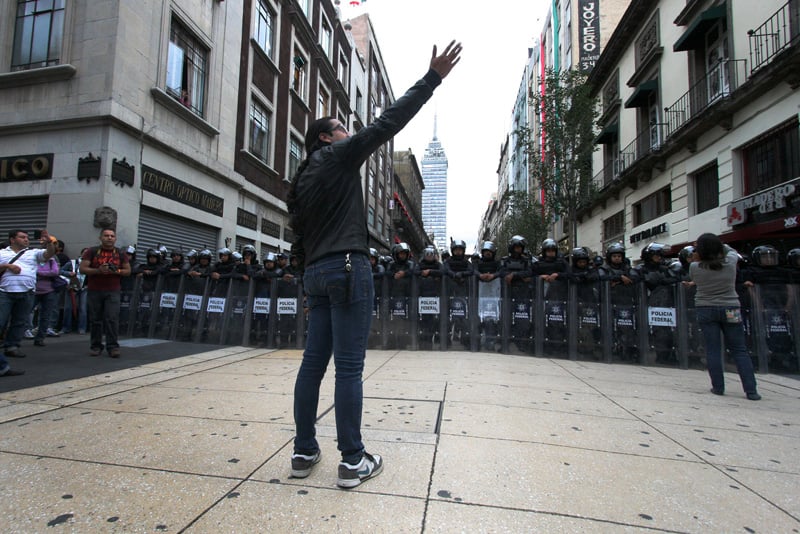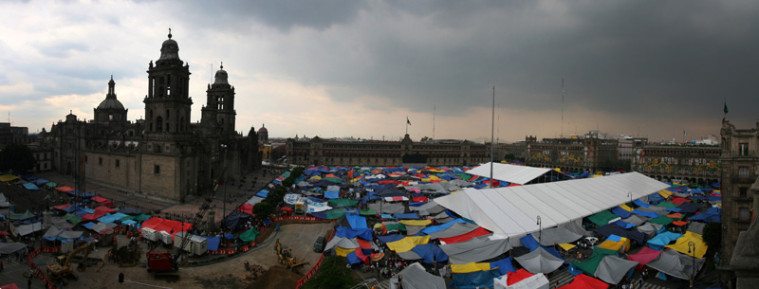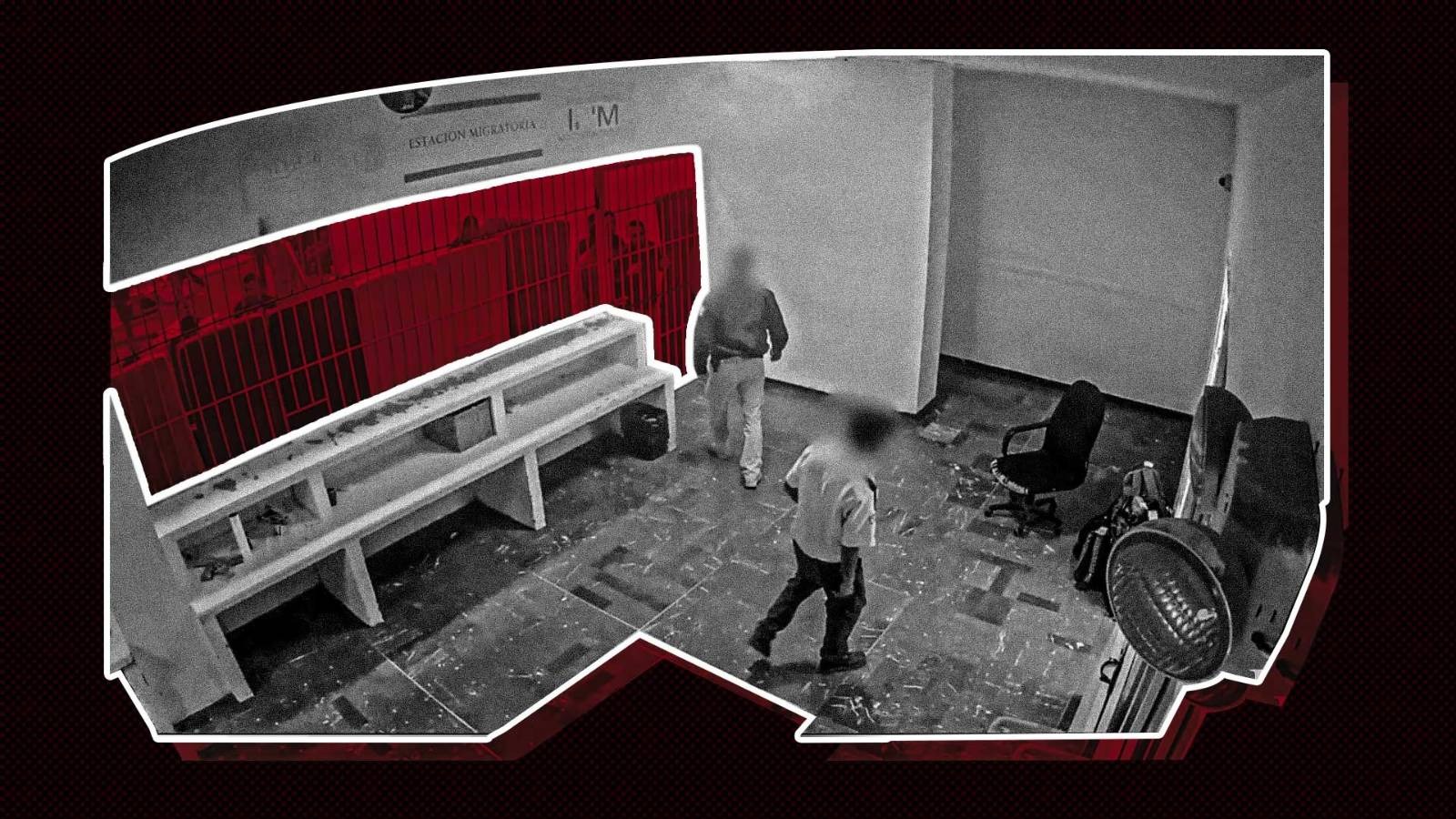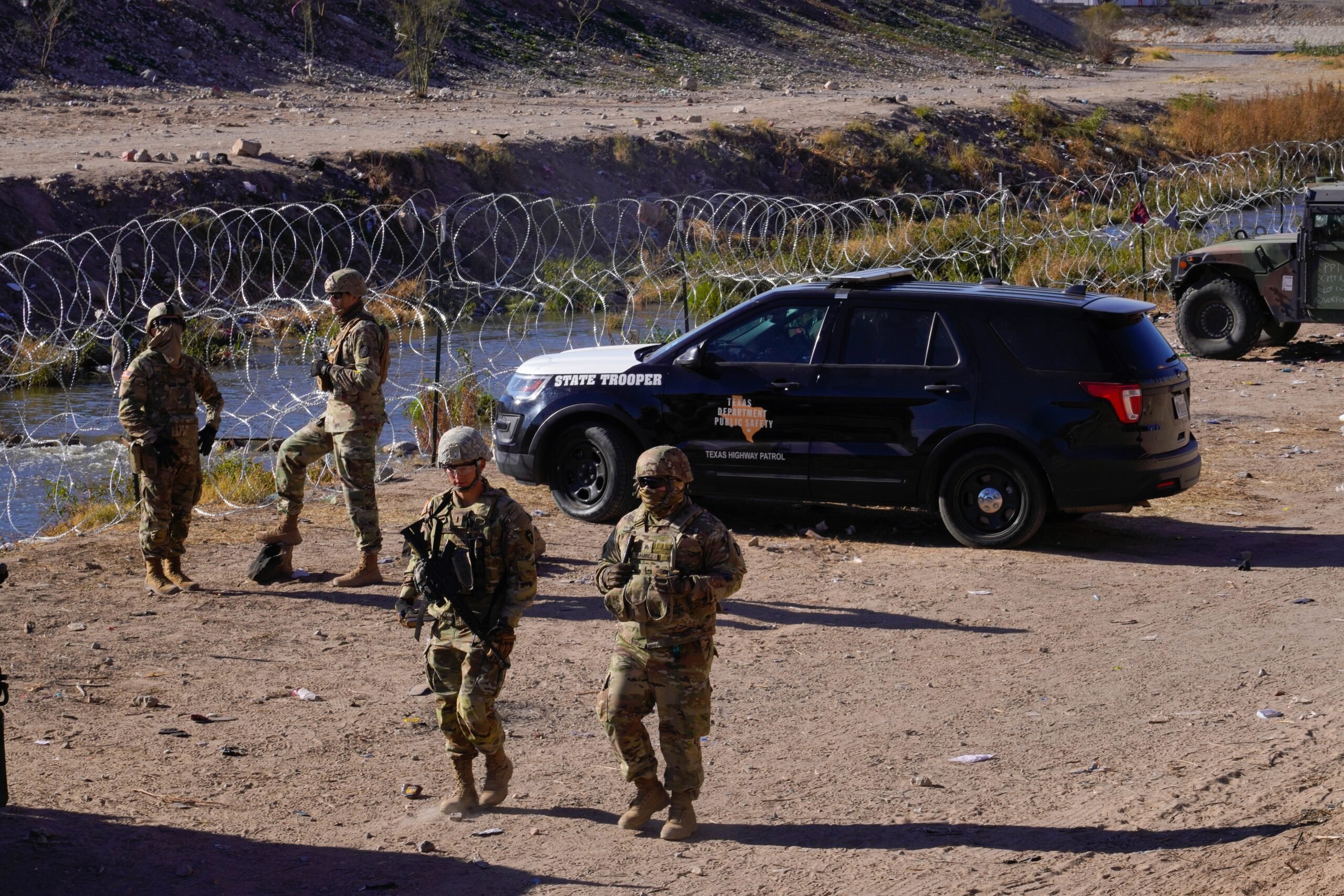
Profiting from Education Reform in Mexico
Above: A protester leads chants in Mexico City's main square, the Zócalo, hours before federal police clear the area Friday, September 13.
On September 12th, the Mexican government gave an ultimatum to the tens of thousands of teachers who had been camping for more than three weeks in the Zócalo, Mexico City’s massive central plaza: everyone out by 4 p.m. the next day. The teachers stayed.
By 4 p.m. on September 13th, helicopters hovered above the iconic cathedral that sits at the northern end of the main plaza; at 4:10 p.m., the orders were givens. Hundreds of police helmets appeared through the smoke left by burning debris. The police chased teachers and other protesters through the central historic district, beating their shields and yelling orders. In a series of disorganized confrontations, protesters and police exchanged tear gas canisters, homemade explosives, sticks, bottles and rocks. Several teachers left in ambulances; a few police officers hobbled back to their cars. By 6:30 p.m., the sun began to set on a relatively quiet capital city.
Teacher-led protests have rocked Mexico City off and on this year as the new president, Enrique Peña Nieto, has unveiled sweeping new reforms to the country’s public education system, changes patterned after the American standardized testing and accountability regime. The protests in mid-September erupted after the Mexican Senate voted 102-22 to approve a set of “secondary” laws: tying hiring and firing decisions to mandatory standardized testing of teachers and students; taking teacher appointment power away from Latin America’s largest labor union, the National Union of Education Workers (SNTE); and increasing the financial autonomy of public schools.
The muscle behind the overhaul includes many of Mexico’s most powerful and profitable corporations and a smaller set of American companies that stand to directly benefit from the private evaluation and testing services.
Proponents of the reforms claim they are a necessary first step in improving a broken education system that last year ranked last among the 34 countries in the Organization for Economic Cooperation and Development (OECD). The reforms, they claim, will weed out incompetent teachers who are to blame for the education system’s shortcomings, echoing similar sentiments in the U.S. Mexican teachers frequently buy, sell or inherit their positions through a corrupt patronage system.
Opponents of the reforms, however, maintain that powerful business interests have hijacked the political decision-making process, leading the misguided call for more evaluations and testing—an argument that will sound awfully familiar in the United States.
Test-based accountability got its start in Texas, spreading nationally with George W. Bush’s No Child Left Behind Act. Texas is where, in the words of education advocate and former U.S. Assistant Secretary of Education Diane Ravitch, “all this testing madness started.” Perhaps it was only a matter of time before it found its way south of the border.
“With these educational reforms, Mexico has been the ultimate copycat,” said Luis Hernández Navarro, editor of La Jornada and author of numerous books on the Mexican education system. “And what’s worse, we are copying a system that has not worked in the United States. We are fighting the same thing as teachers in Chicago and California.”

Standardized testing has become a landmark of the public education system in the United States, a tool used to evaluate students, teachers and an entire educational system. Under No Child Left Behind and Race to the Top, American students are tested every year beginning in third grade. U.S. Secretary of Education Arne Duncan has acknowledged serious flaws in the tests and the National Research Council reported that there was no evidence that standardized testing adequately measures performance.
Nevertheless, standardized testing has become highly profitable for educational service providers. Last year, the Brookings Institution estimated that state-level spending on standardized testing reached $1.7 billion. Six vendors accounted for 89 percent of the total, with UK-based Pearson Education accounting for the largest share at 39 percent. In Texas, the company is paid an estimated $2.1 billion annually to develop new test questions, according to the Texas Education Agency. Last year, the company recorded sales worth $5.7 billion in North America alone, while worldwide sales reached $9.7 billion with profits recorded at $1.5 billion.
The company has celebrated the education reforms in Mexico. Pearson Mexico president Philip de Vega called it “an opportunity to show Mexico the diversity of tools that our company possesses.” Mexico has been a key market for Pearson. The company has secured contracts with some of the country’s largest public and private universities and is developing textbooks, evaluation tools and prep courses for teachers who will be tested under the new reforms. Earlier this year, Pearson acquired the distribution rights of Voxy, a U.S.-based English language platform doing business in Mexico. “What we offer here in Mexico are direct adaptations of our U.S. programs,” he added. “They are simply adjusted to include local content.”
For opponents of Peña Nieto’s education reforms, the Mexican education system is clumsily following the path to privatized education and standardized testing blazed by its powerful northern neighbor. According to researchers from Mexico’s National Pedagogic University and Iberoamerican University, Lucía Rivera and Carlos Muñoz Izquierdo, Mexican schools are increasingly competing for federal money in an educational system dictated by private interests, a practice clearly established in the United States.
“Education reforms in Mexico have essentially been a business proposal,” said Hugo Aboites, a Harvard-educated professor at the Mexican Autonomous University. “It is a proposal aimed to promote economic development.”
In Mexico, education reform’s biggest cheerleader has been a group called Mexicans First. Described by its members as a diverse, independent citizen’s initiative, Mexicans First is comprised of some of the top brands and corporations in Mexico: Televisa, Palacio de Hierro, Modelo Group—manufacturers of Modelo, Corona, Pacifico, Negra Modelo beers—as well as dairy giant Lala, Aeromexico, Cinépolis, Bimbo and Santander.
Two months after Peña Nieto was elected, Mexicans First published a document entitled “The Time is Now: 2012-2014 Goals.” Among the many recommendations, the report called for curtailing the power of SNTE. Indeed, the union was once a close political ally of the PRI, the political party which ruled Mexico for 71 years, until 2000, but has recently returned to power with Peña Nieto’s election. The PRI, through the union, has long-controlled the sale and inheritance of some teaching jobs. Yet shortly after Peña Nieto took office in December, he orchestrated the removal of long-time SNTE leader Elba Esther Gordillo, who was accused of embezzlement of funds and jailed in February. The report also called for more teacher evaluations and test-based accountability as well as greater autonomy of the governmental National Institute for the Evaluation of Education (INEE), the body that oversees testing and evaluations. In April, a member of Mexicans First, sociologist and OECD advisor Sylvia Schmelkes, was installed as head of the INEE.
“The report published by Mexicans First, together with OECD proposals, essentially wrote these reforms,” said Aboites. “These businesses want our children and students to be good capital for our growing capitalist country. Bimbo and Televisa. This is the government’s agenda.”
The quality of the Mexican educational system varies greatly from state to state. The first teachers to arrive in Mexico City, and the ones who have stayed the longest, have come from Chiapas, Oaxaca and Guerrero, some of the poorest and most rural states in Mexico.
“No one here in the capital has any idea what it’s like to ride a bus for hours to teach to children that don’t speak Spanish in schools where there is no running water,” said Citlali Santiago, who at age 24 has been already been teaching for three years. “National standards say that by the first year of elementary school you should be able to read. In Oaxaca, that is when many children are learning to speak Spanish.”
Similar criticisms were leveled against No Child Left Behind, whose standards for teachers and students were especially problematic for small, rural schools to meet. Similarly, in Texas studies have shown that such high-stakes testing was largely failing already marginalized populations, particularly Latino youth. In the early days of testing in Texas, schools could even exempt test scores from students with limited English.
“We can compare the Mexican education system to a poorly marked highway full of potholes,” said Pedro Hernández, a union leader. “We teachers have been asked to drive an old, rattling, poorly running truck down this road. We can’t simply blame the driver for what they’re able to do in these circumstances.”’
Although the teachers have understandably struck a nerve in the capital, costing local businesses an estimated $60 million in lost business to date, their voices join those of teachers across the United States and throughout the world who have denounced the increasing importance of standardized evaluations in education and the role of private companies in the decision-making processes that most affect students and teachers.
On Wednesday, union teachers marched with other protesters, surrounding the Angel of the Revolution on Reforma Avenue. Thirty nine protesters were detained and 12 police officers were injured.
“We’re not going anywhere until this is resolved,” said Pedro Hernández, a teacher from Oaxaca. “We are no longer a teacher’s movement, but a disciplined army of concerned citizens.” Laughing, he added, “And what’s more, we’ve learned how to effectively use the Metro.”


